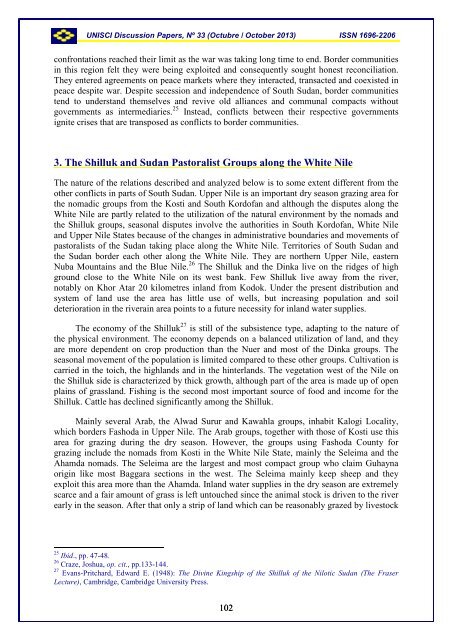UNISCI - Universidad Complutense de Madrid
UNISCI - Universidad Complutense de Madrid
UNISCI - Universidad Complutense de Madrid
Create successful ePaper yourself
Turn your PDF publications into a flip-book with our unique Google optimized e-Paper software.
<strong>UNISCI</strong> Discussion Papers, Nº 33 (Octubre / October 2013) ISSN 1696-2206confrontations reached their limit as the war was taking long time to end. Bor<strong>de</strong>r communitiesin this region felt they were being exploited and consequently sought honest reconciliation.They entered agreements on peace markets where they interacted, transacted and coexisted inpeace <strong>de</strong>spite war. Despite secession and in<strong>de</strong>pen<strong>de</strong>nce of South Sudan, bor<strong>de</strong>r communitiestend to un<strong>de</strong>rstand themselves and revive old alliances and communal compacts withoutgovernments as intermediaries. 25 Instead, conflicts between their respective governmentsignite crises that are transposed as conflicts to bor<strong>de</strong>r communities.3. The Shilluk and Sudan Pastoralist Groups along the White NileThe nature of the relations <strong>de</strong>scribed and analyzed below is to some extent different from theother conflicts in parts of South Sudan. Upper Nile is an important dry season grazing area forthe nomadic groups from the Kosti and South Kordofan and although the disputes along theWhite Nile are partly related to the utilization of the natural environment by the nomads andthe Shilluk groups, seasonal disputes involve the authorities in South Kordofan, White Nileand Upper Nile States because of the changes in administrative boundaries and movements ofpastoralists of the Sudan taking place along the White Nile. Territories of South Sudan andthe Sudan bor<strong>de</strong>r each other along the White Nile. They are northern Upper Nile, easternNuba Mountains and the Blue Nile. 26 The Shilluk and the Dinka live on the ridges of highground close to the White Nile on its west bank. Few Shilluk live away from the river,notably on Khor Atar 20 kilometres inland from Kodok. Un<strong>de</strong>r the present distribution andsystem of land use the area has little use of wells, but increasing population and soil<strong>de</strong>terioration in the riverain area points to a future necessity for inland water supplies.The economy of the Shilluk 27 is still of the subsistence type, adapting to the nature ofthe physical environment. The economy <strong>de</strong>pends on a balanced utilization of land, and theyare more <strong>de</strong>pen<strong>de</strong>nt on crop production than the Nuer and most of the Dinka groups. Theseasonal movement of the population is limited compared to these other groups. Cultivation iscarried in the toich, the highlands and in the hinterlands. The vegetation west of the Nile onthe Shilluk si<strong>de</strong> is characterized by thick growth, although part of the area is ma<strong>de</strong> up of openplains of grassland. Fishing is the second most important source of food and income for theShilluk. Cattle has <strong>de</strong>clined significantly among the Shilluk.Mainly several Arab, the Alwad Surur and Kawahla groups, inhabit Kalogi Locality,which bor<strong>de</strong>rs Fashoda in Upper Nile. The Arab groups, together with those of Kosti use thisarea for grazing during the dry season. However, the groups using Fashoda County forgrazing inclu<strong>de</strong> the nomads from Kosti in the White Nile State, mainly the Seleima and theAhamda nomads. The Seleima are the largest and most compact group who claim Guhaynaorigin like most Baggara sections in the west. The Seleima mainly keep sheep and theyexploit this area more than the Ahamda. Inland water supplies in the dry season are extremelyscarce and a fair amount of grass is left untouched since the animal stock is driven to the riverearly in the season. After that only a strip of land which can be reasonably grazed by livestock25 Ibid., pp. 47-48.26 Craze, Joshua, op. cit., pp.133-144.27 Evans-Pritchard, Edward E. (1948): The Divine Kingship of the Shilluk of the Nilotic Sudan (The FraserLecture), Cambridge, Cambridge University Press.102
















